
The Lodger as "Deaf Cinema" (see Michel Chion); or is Hitchcock's "deaf" cinema also a cinema of writing / recording media rather than speech?
Some notes by Richard Burt, published here February 25, 2013.
The frame without a picture above the lodger's head when he recovers near the end of the film as the blank screen of film projection?

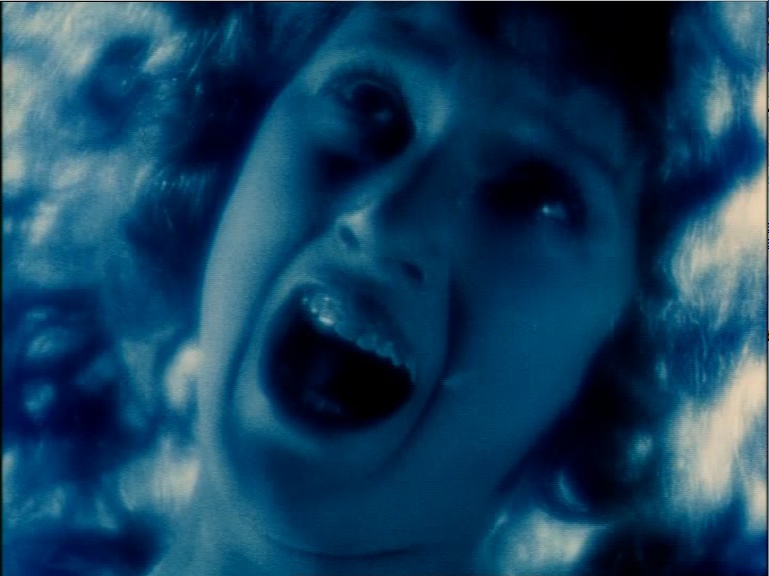
The first shot of The Lodger (above), the first blonde victim of the Avenger screaming (although it turns out to be the Avenger's seventh victim, all blondes).
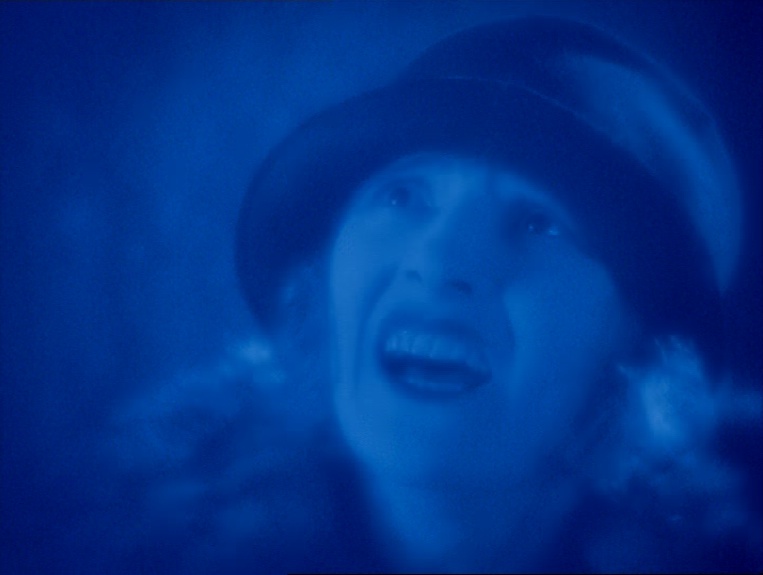
The Avenger's second victim screaming, very similar shot as the shot of the first victim above this one. It would appear that the women playing the victims look very similar or tha thte same actress plays both victims.
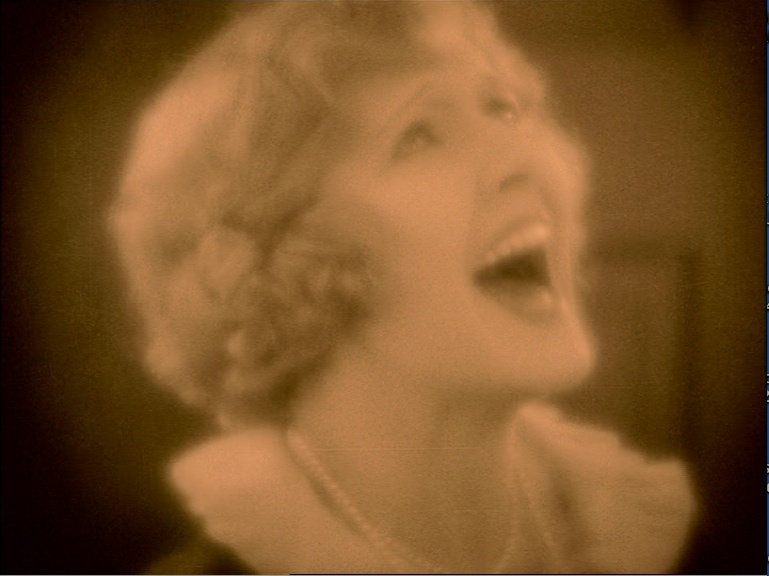
Daisy: Screaming or Laughing? The shot of Daisy reverses the shots of the victims, making her expression parallel to theirs while flipping the direction of her face and shooting her more in profile than the murder victims. She also gets an iris. It turns out she is screaming--at a mouse. The shot above is also a much shorter take the the two of the murder victims, opening up the possibility that she is laughing, not screaming.
The first murder victim of the Avenger, the lodger's sister, seen below, is framed like the two shots of the first two murder victim, but the sister's facial expression is less one of fear or pain than of ecstasy. This shot is held longer than the others, begins with the sister opening her eyes and tehn closing them quickly.


More notes on female facial expressions and sound. Here is a shot of Daisy laughing (see more below) in hte bathroom after she has gotten out of the tub.
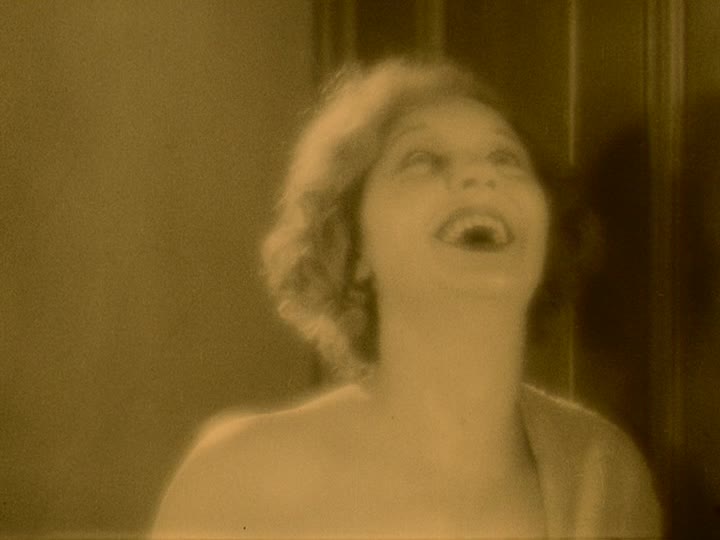
In the blu-ray soundtrack, composer Nitin Sawhney uses the same music for the first and second murders. Although in the shot above, just after Daisy's parents and fiancé think they hear her scream in her room above them because she is being attacked by the lodger. We see Daisy (above) in one of three quick takes, her close up framed by two shots before and after it (also close-ups and of the same duration) of actions that look like the consequences of a struggle. How we read Daisy's expression turns on vision, on the Kuleshov effect editing of the three shots, not the sound.
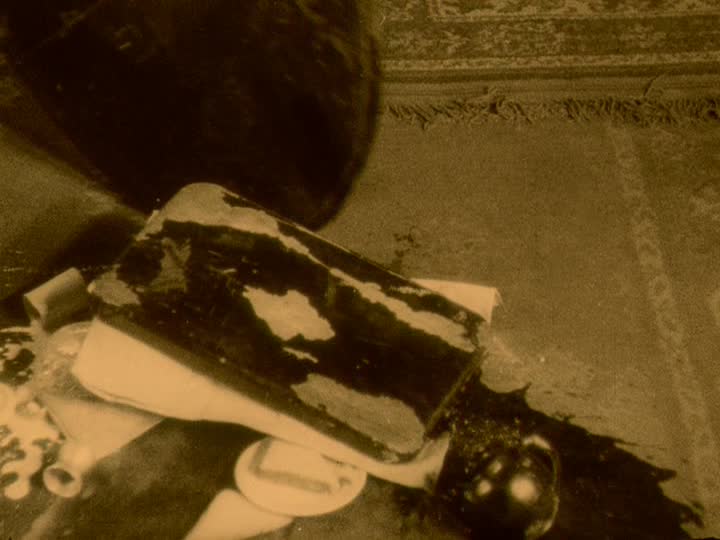
A table falls over and the breakfast tray and food it spill on the carpet. That is in the lodger's room. Cut to Daisy's face, in a close-up.

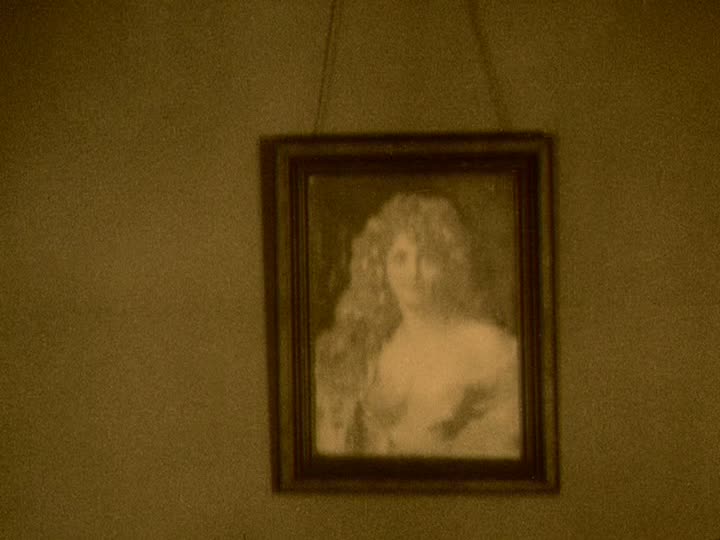
As the portrait of a blonde falls (above), also in close up, the film cuts to Joe getting up out of his chair (below). In a later medium long shot, Joe stands almost directly in front of the blonde portrait so that his head is the same size as the woman's in the portrait. (See below)

At the end of the shot above, Joe and the parents are looking up at the ceiling. In the first of three times Joe finds the lodger and Daisy seemingly in flagrante flirtatio, Daisy explains that she was just frightened by a mouse. The editing clearly makes us side with Joe. We make the same mistake he and Daisy's parents make. As if taking Joe's side, Sawhney uses an onomapoetic music scream that differs but recalls the the scream music used in the close ups of the two victims screaming bloody murder shots above. After Joe enters the room, we cut to something like a reverse shot of Daisy laughing with the lodger, each in the other's arms. The music scream strengthens the visual parallel Hitchcock constructs between the facial expressions of the Avenger's murder victims and the facial expression of the Daisy, making us think that the lodger is the Avenger. The same ominous music continues in what becomes a reverse pov shot of Joe's as the camera dollies on the lodger after Joe has moved to the camera from their side of the room. In the reverse pov shot from Joe's perspective, Daisy and the lodger are still in each other's arms (a seemingly compromising position that is not explained by a mouse; we go from one kind of guilt--harm to Daisy caused by the lodger--to another--Daisy's romantic betrayal of Joe, or from one misunderstanding to another not quite misunderstanding since Daisy does dump Joe).
Hitchcock wanted the lodger to turn out to be the Avenger, as he is in the novel by Mrs. Belloc
Lowndes on which Hitchcock's film is based. The producers of The Lodger forced Hitchcock to give the film a happy ending because the actor who plays the lodger, Ivor Novelo, was a star and therefore, the producers said, he couldn't play a villain. Sawhneys's music arguably matches the film Hitchcock the film wanted he wanted to make.
What does it mean when Daisy laughs? Daisy laughing in the bathroom at the lodger telling her what her father thinks.

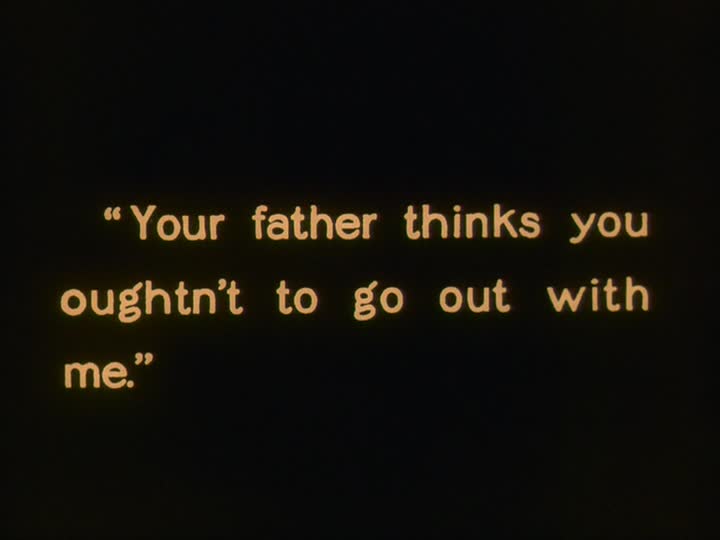

The lodger hears Daisy laugh twice, first when he arrives at the lodging. She is laughing after her father has fallen off his chair just after repairing the cuckoo clock (another sound we don’t hear; but here we see by the lodger's facial expression that he does hear it).


The second time occurs when she arrives at the lodger’s room and sees him turning around one of the paintings of a blonde he has asked the landlady to remove. Long takes on his response to hearing. The second time his back is to her.



Is Daisy psycho? What is her relation to her mother? Is the mother psycho, by the way? She seems almost telepathic with respect to the lodger's movements (she hears him leaving and returning before and after the second murder). The Expressionistic lighting--the shdow of the window , almost straight out of The Cabinet of Dr. Caligari--in her room (see the shot below) suggests she may be a bit demented.

Why does she like the lodger and dump Joe, anyway? They have two fights, the second time after he catches her in the lodger's arms in his room, and they make up both times. Is the happy ending all that happy given the way the two shots of the couple below loop the film the end of the film back to its beginning ("to-night golden curls" is also a loop, like a gif, of course)?
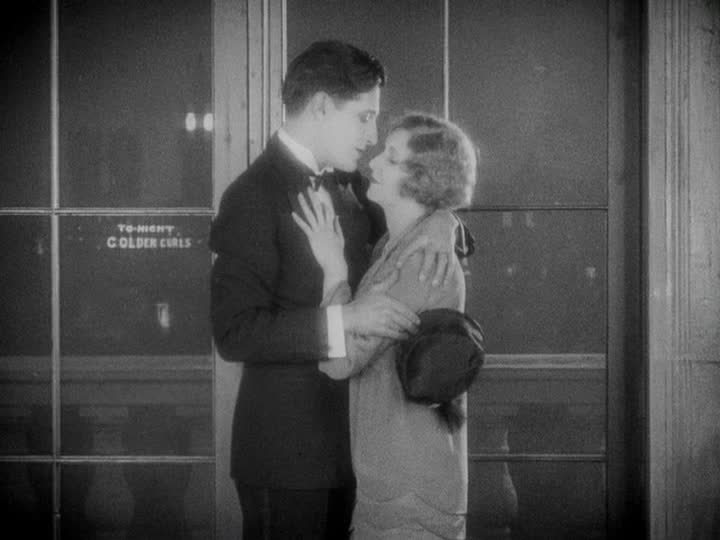
There is a brief dolly in (above) before cutting to the parents downstairs before cutting back to the same shot (below).
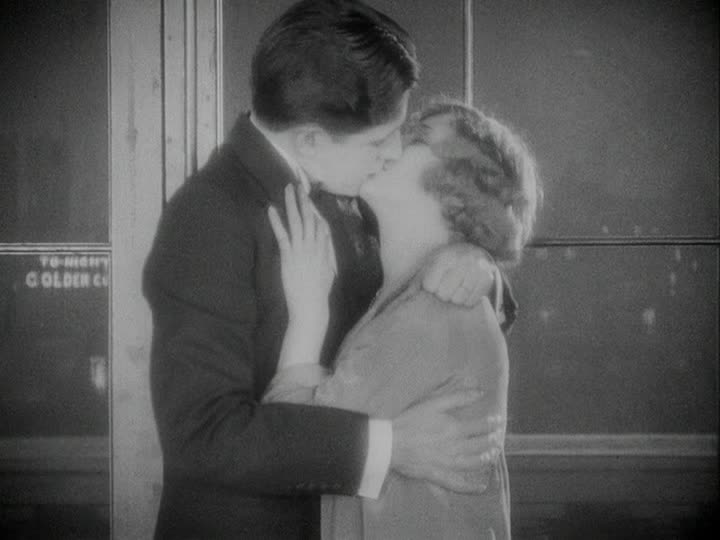
Camera dollies from the shot above to the close up of Daisey below before fading to black.
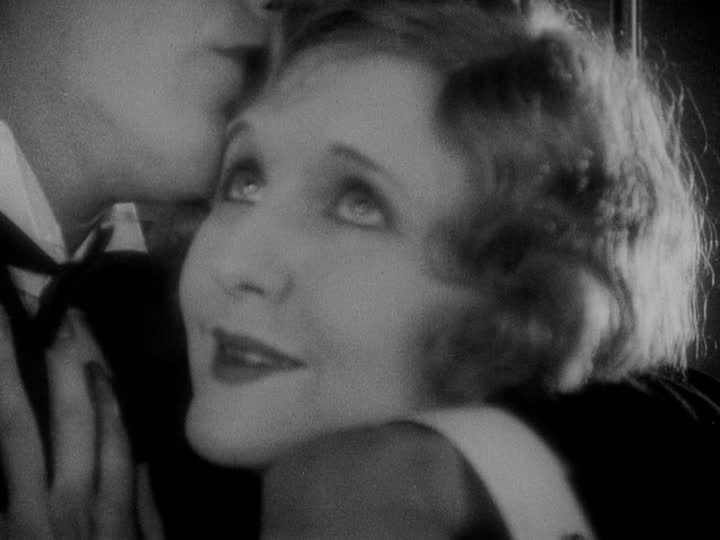
Dd Hitchcock sneak in the ending he wanted with the close up on Daisey looking ecstatic (happy and crazy) and the return of "To-night Golden Curls" in two shots?
Things happen twice frequently in The Lodger: the second shot of the film (of the corpse of the murder victim) is repeated, as is the title "tonight-golden curls"; the cuckoo clock goes off twice, almost identical shots; father repairs the cuckoo clock twice; we see Daisy modelling twice (exact same establishing shot); we see the women backstage undressing after "Golden Curls" twice (exact same establishing shot); Daisy and the lodger go the lamp twice; the lodger pulls up his coat lapel as had hte guy at the food stand near the beginnning of the film; teh ldoger's map with triangle on it and triangels inside looks like the map Joe pulls out at the police office, that that map doesn't look like itself; etc.
More fear turning to laughter in the dressing room after Golden Curls ends (the first time). This woman turns out to be the Avenger's second victim we see (his eighth victim in the diegesis)
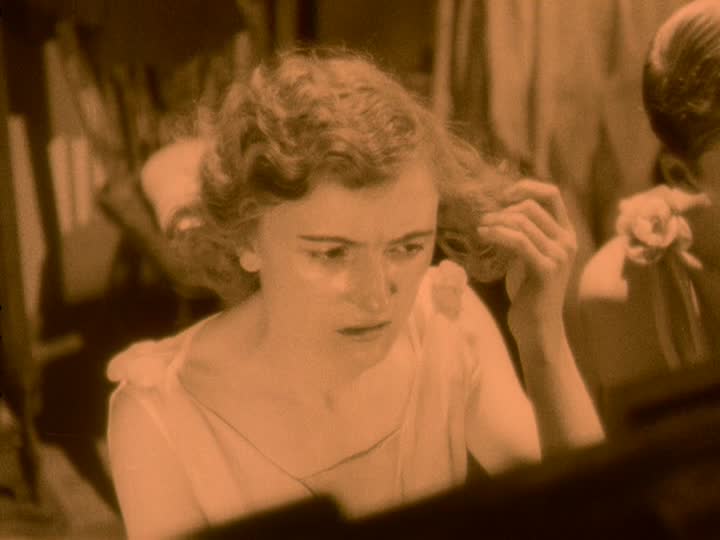

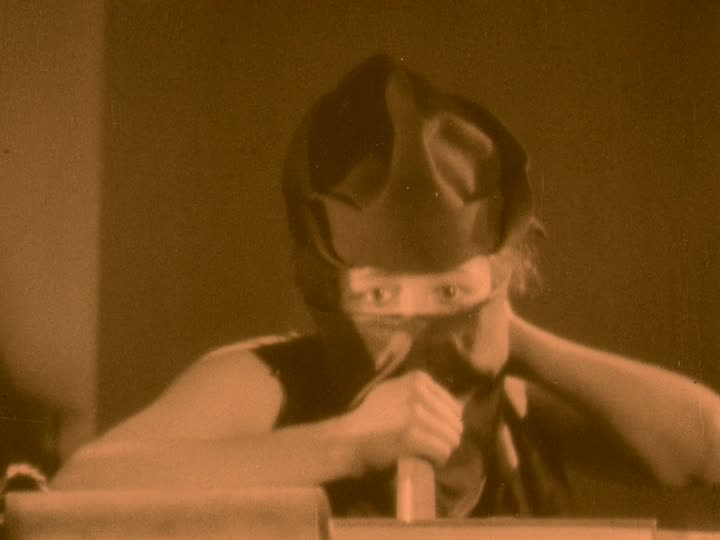
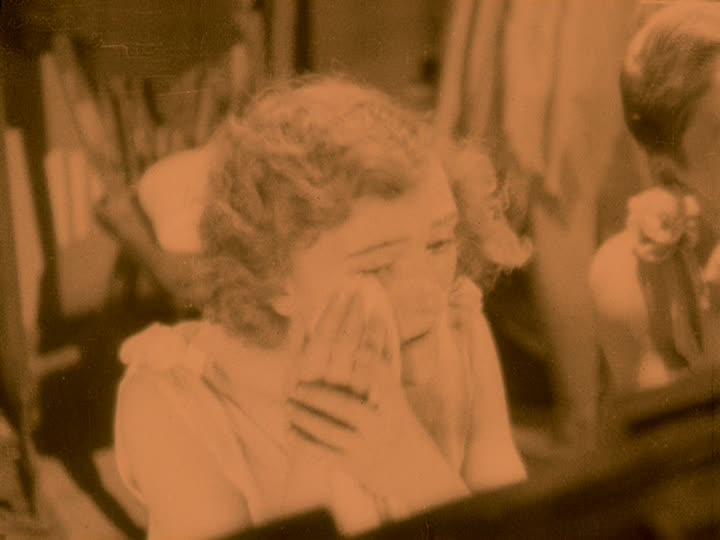
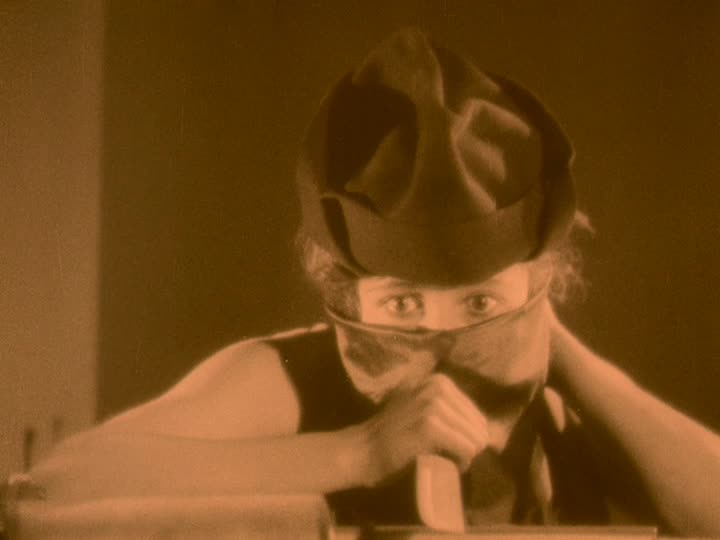
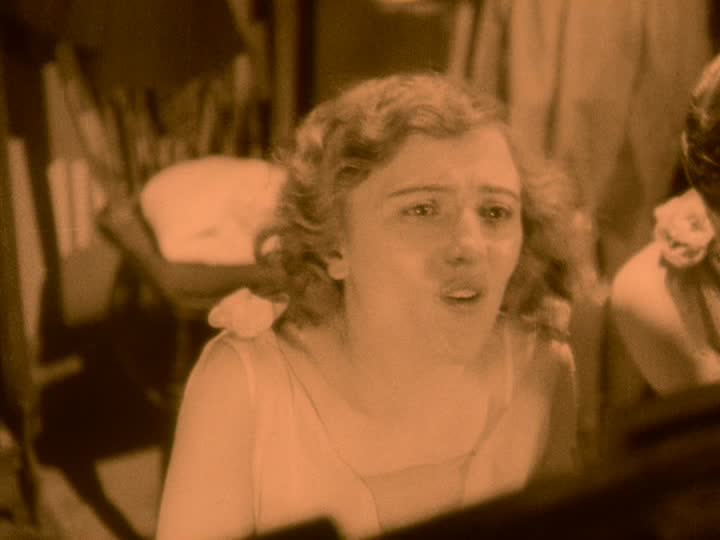
Mock fear happens earlier at the food stand when the witness talks and a guy pulls up his lapel and then the witness is frightened when she hees his distorted reflection. Turns out to be a bad joke. No one likes it. The owner of the stand knocks the joker a bit and the joker gets very defensive.
The man at the stand after the first murder victim pulls up his lapel to look like the Avenger the woman witness is describing:

The woman witness mistakenly identifies the guy joking with her when she sees his distorted reflection below:

And here is the lodger doing the same thing:

The opening sequence, starting with the first shot of the woman screaming and then to third shot of the woman witness speaking, sets up a train of transmission from her words to the newspaper being sold by the man on the street cross-cut with the crowd looking at the electronic sign showing a similar headline. This linear chain includes a mix of speech (that we cna't hear) and recording media print (handwriting we don't see), telephone (more speech we can't hear or lip read), telegrams (we can read), to news printing, to poster with headline we can read on delivery car, and finally delivery and sale on the street. This linear transmission periodically loops back to speech. There are also other repetitions at odds with linear narrative. In this sequence just described, the first shot of the witness shows a man in the left side of the shot writing down what she is saying. We cannot see the man's face, but we can see he is dressed in civilan clothes. The next shot shows the cop writing down, then we cut back to the woman this time with the reporter appearing to copy down the policeman's notes. But this reporter has to have been the man whose face we didn't see in the first shot. Since he can hear the woman speaking as well as the cop, why does he copy from the cop? Similarly, in the shot with the faces of people listening ot the aerial dissolving from one into another, then another, they seem to be reacting one at a time when actually they should all be reacting at the same time since they would all be listening at the same time to the same pair of earphones they all seem to be wearing and almost tortured by (compare the first scene of The Artist?).
Joe's vision of the lodger's supposed guilt when he stares at a footprint after Daisy throws him over is a kind of echo of the scene above.

Does it matter that we can't lip read or hear what characters are saying when no intertitles are provided to tell us what they are saying? For example, we don't see what the newspaper man is saying on the phone, nor can we lip read what the man on te receving end of the call is saying becuase the phone obscures our view of his mouth. After Daisy makes up with Joe a second time downstairs, she tells him something in his ear. He then smiles and sort of pushes her shoulder, joshing her. We never know what she said to him. he is clearly baffled, even abject after they kiss and she runs off and goes upstairs. He turns his back to the camera. (more belowThe lodger does not have a name. Characters always refer to him as the "lodger." When he knocks on the bathroom door when Daisy is singing in the bathtub, there are two shots of her syaing (if we lip read) "who is it?" After the second time, the lodger says something with two syllables. When Daisy goes to the door, she asks again "WHo is it?" and hte lodger doesn't answer. So whatever he said in two syllables, he didn't say his name. Or if he say it, she didn't hear it. Similarly, we never see the avenger except perhaps in the opening title "The Lodger." Is that the lodger in the drawing? Or the avenger? The only time a witness identifies someone, she is wrong. The woman witness at the food stand mistakes a guy pulling her leg for the lodger. Are we always seeing the wrong man? Is hte lodger innocent even if he is not the avenger and not only because he has a gun he plans to murder the avenger with?
Shots of the lodger's lodging sometimes make it difficult to know where we are. There's a basement level with basement level entry, a street level entry first floor and a kind of living room next to it before the stairs, and the lodger lives upsatirs on the second floor.

But there are inconsistencies and uncertainties. Sometimes the lodger's room is right by the stairs on the second floor (when the mother and the lodger run out after hearing Daisy scream when Joe has hancuffed her; the editing makes Joe look much more guilty to the lodger than he does to us, and she forgives him afterwards; and when the lodger leaves and returns before and after the second victim is murdered). When Daisy, Joe and the mother look at the ceiling and see the chandlier moving because the lodger is pacing upstairs and when Daisy alone does later, they seem to be in one room; when the parents look up at the moving chandlier, they seem to be in a different room. At other times, the lodger's room appears to be in the middle of the hallway (when the mother searches the room and also when the father returns the dress the lodger bought Daisy). Where is the the bathroom with the bathtub Daisy is bathing in? The portrait that falls after Daisy screams at the mouse appears to be in the lodger's room. Where is it? Apparently in the room off to the right of the street level entrance. But the shot of the portrait falling seems to be happening in the same space as does the overturned breakfast tray because both are shot in parallel close-ups of similar duration.

Joe's head obscures the portrait, conspicupously so when he moves slightly to our right and we see it briefly. We have seen Joe turn his back to the camera (like Hitchcock does in his cameo) in utter abjection. Joe says to Daisy that he shares the avenger's preference for blonde curls. Is Joe psycho too? Is the blonde his unconscious?

Is almost everyone in the film psycho? Why does the second murder victim stamp her foot and leave her boyfriend when she knows the murderer is probably out there?
Where does the mother sleep? On the third floor above the lodger?
More deaf cinema in The Lodger.
Hitchcock in a cameo speaking into a phone with his back turned to us so we can't read his lips.
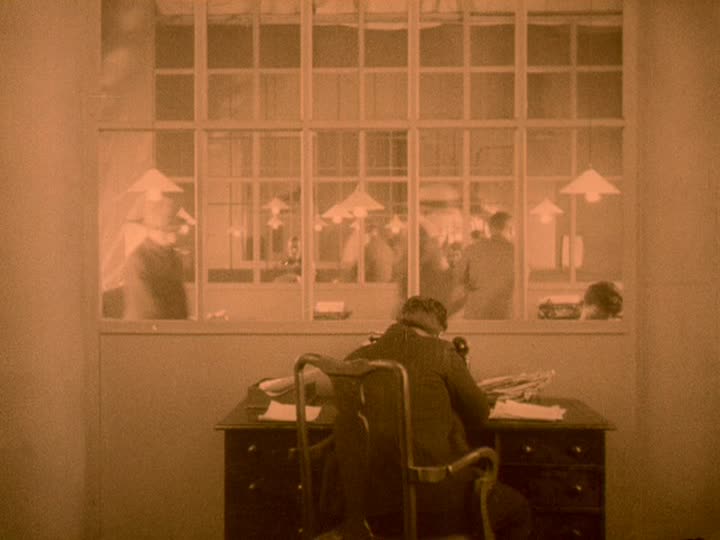
Daisy hears the news seller when she is modelling.

Poster in the shot above gives the number of the first victim, the seventh, as did the telegram earlier.



There is no intertitle for newspaper man's dialogue when Daisy hears him, nor the second time we he is shot in the dressing room. The hearing is impossible and we only learn what the guy says after we go back stage and hear Daisy tell the others "He’s killed another fair haired girl." Since at least three of these women were also on stage modeling for the gentleman joyously oggling the young women flanked by two well-dressed, elderly women shopping, why did she alone hear it? Back stage where the models talk, the newsaper man is twice intercut, and the third time we see he has no front teeth.
So Daisy did hear the guy on the street. But all we can read on his poster is “ANOT” for "Another." The text he holds is not continuous with the text, fully legible, in the shot of the newspaper man that fades to black before we the intertile for "Daisy." Is there a pun on “Anot,” as in "a k/not?" Does it matter that the texts do not match? or that there is a fade to black, possibly indicating a temporal ellipsis? If so, why is there an elipsis when it appears to be the same guy selling the newspapers?


and then we go the shot shown above, seen now below.

Apparently, he is shouting "Another Avenger murder!," if we match the text to the earlier text "Seventh Avenger Murder" and to Daisy's intertitle "He killed another fair haired girl." Why do we move from "seventh" to "another" rather than "eighth?" Does serial murder only become serial have the seventh murder? When Joe goes through the news clippings he finds in the lodger's locked up doctor's bag, the numbers "first, "second," and third," but then give way to "another clue fails" and "another." The series goes off track.
Alfred Hitchcock, The 39 Steps (1935) (scream as train whistle when the maid discovers Annabelle's corpse in Richard Hannay's apartment); Madeliene's / Judy's scream in Vertigo (1957) (we hear the scream but do not see the screamer when Scottie see "Madeleine" die: in Judy's flashback, we see Gavin Elster stop Judy from screaming after he has thrown over the corpse of his wife; at the top of the stairs after overcoming his vertigo, Scottie says to Madeleine that she screamed and she doesn't say she didn't. We hear Judy scream but do not see her fall when the nun appears by the bell.
(Sort of) Recommended Reading: Elisabeth Weis, The Silent Scream : Alfred Hitchcock's Sound Track